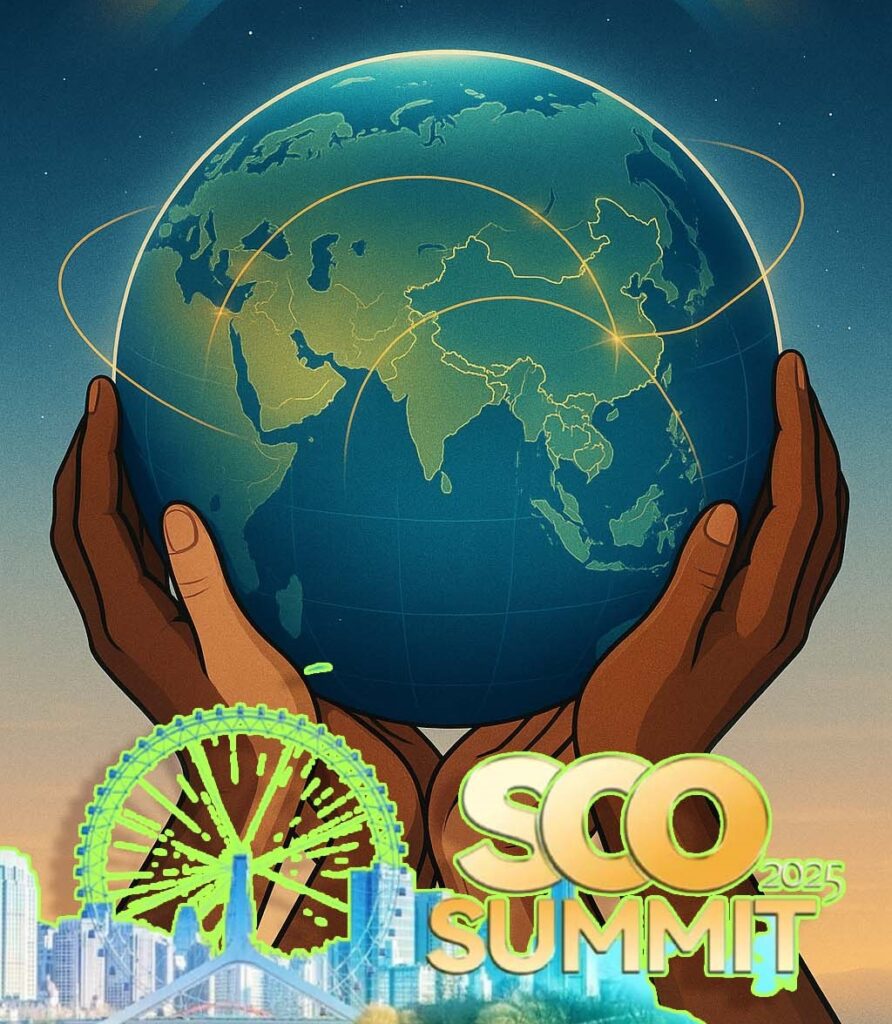
- This refreshing SCO bonhomie in 2025, especially among the three principal global actors (China, India, Russia), underscores the truism that everything is in the realm of possibility in the conduct of diplomacy and foreign affairs of sovereign states.
- The confabulations and resolve at Tianjin for “mutual trust, mutual benefit, equality, consultation, respect for diverse civilisations, and pursuit of common development” could bring about some sobriety on the global chessboard.
- As seen in the evolution of the UN-led world order, we need balanced and futuristic scholarly contributions to the global knowledge pool to provide 21st-century solutions to the global problems of the 21st century.
On September 01, 2025, the Tianjin Declaration adopted at the Shanghai Cooperation Organization (SCO) alluded to the shared future for humankind. The spirit of the call reflects upon the futuristic theme: “One Earth, One Home, One Future.” The reflection of this realisation about our common planetary co-existence is premised upon the bedrock of profound geopolitical changes in the landscape of International Law and International Relations, as well as its wider ramifications for multilateralism in the second quarter of the 21st century. The Declaration by the Heads of Government of ten members including President Xi (China), Prime Minister Modi (India) and President Putin (Russia), solemnly agreed to “fully abide by the purposes and principles of the UN Charter (1945) and the SCO Charter (2002), as well as other universally recognized principles and norms of international law”.
This refreshing SCO bonhomie in 2025, a decade after India joined the SCO, especially among the three principal global actors (China, India, Russia), underscores the truism that everything is in the realm of possibility in the conduct of diplomacy and foreign affairs of sovereign states. The key to resolving the puzzle of “how nations behave” (Henkin, 1968) lies in the minds of human beings who are not infallible in the conduct of external affairs of their respective countries. As the mind games are at work beyond the ‘theories’, the subtle visible and invisible messages from Tianjin indicate possibilities for new need-based realignments. One such could be the revival of the Russia-China-India (RIC) process, even as the future of another multilateral process (QUAD) remains uncertain.
The confabulations and resolve at Tianjin for “mutual trust, mutual benefit, equality, consultation, respect for diverse civilisations, and pursuit of common development” could bring about some sobriety on the global chessboard. This is especially so since the grouping has adopted an ambitious “SCO Development Strategy for the Next 10 Years (2026-2035).” Even as the storms are gathering for the “planetary crisis” (here, here, here) as well as accentuated misery and grave risks are faced by two billion people trapped in the “global conflicts” (61 state based, 74 non-state and one-sided violence), the United Nations General Assembly (UNGA) opened its historic 80th session on September 9, 2025 wherein Annalena Baerbock (Germany) became the fifth woman President with a theme: “Better Together: 80 years and more for peace, development and human rights”.
Towards the end of the 79th session, the UNGA adopted a futuristic resolution 79 (321) on July 25, 2025, for attaining a “culture of peace”. It has been defined as “a set of values, attitudes, traditions and modes of behaviour and ways of life” (resolution 53/243 of September 13, 1999). The year 2025 began on a positive note, wherein the plenary organ of the UN – the General Assembly – took cognisance of the global pall of gloom on various fronts. Hence, the UNGA asserted “the relevance of hope and well-being as universal goals and aspirations in the lives of human beings around the world and the importance of their recognition in public policy objectives” (resolution 79/270 of March 04, 2025). Continuing with this trend of going to the roots that nurture the humankind, the Assembly invoked resolution 79/315 of June 30, 2025 (mooted by the Latin American countries) on the Wiphala tradition reflecting upon the “multicoloured rainbow, composed of seven colours harmoniously arranged in a geometric grid pattern, inspired by the order, harmony and beauty of Nature” especially since it “embodies a unity of values and ways of life grounded in respect for life”. It is indicative of the growing acceptance of humankind’s umbilical link with Mother Earth that finds reflection in the ancient Indian tradition (“O Earth, my mother, set thou me happily in a place secure”; Atharva Veda Book XII, Hymn 1).
In the multilateral processes, however, the above-mentioned allusion by the political organ in the 80th anniversary year (1945-2025) of the UN, provides a ray of hope for touching the conscience of the 193-member states for behavioural change to address the global environmental challenges. Such a multilayered approach, in conjunction with working on the hard and soft instruments, could provide an impetus for taking the different facets of the “planetary level crisis” (here, here, here) seriously.
The UN Secretary-General has, in one of his last addresses (August 01, 2025) to the 79th UNGA, spelt out an ambitious “UN80 Initiative” (resolution 79/318 July 18, 2025) on the 80th anniversary of the UN. Significantly, the UNGA resolution (79/321 on July 25, 2025) falls back on the dedicatory line in the preamble to the 1945 UN Charter (“to save succeeding generations from the scourge of war”; Preamble) as well as the 1945 UNESCO Constitution (“since wars begin in the minds of men, it is in the minds of men that the defences of peace must be constructed”; Preamble). The resolution has explicitly recalled the United Nations Millennium Declaration (UNGA resolution 55/2 of September 8, 2000) and the 2030 Agenda for Sustainable Development (UNGA resolution 70/1 of September 25, 2015). These references matter most at this critical juncture since all the conflict zones, natural disasters and other contingencies have severely impacted the human progress, attainment of peace and realisation of the goals laid down in the MDGs (2000-2015) and the SDGs (2015-2030).
The quest for just and lasting peace for the protection of the planet, as well as present and future generations, is premised upon the strengthening of “universal peace” and “living together in peace” (resolution 79/270 of March 04, 2025). They have been regarded as prerequisites for the needs of the present and future generations. It is no less significant that the political organ of the UN seeks to keep humankind rooted to the ground to embody “a unity of values and ways of life grounded in respect for life” (resolution 79/315 of June 30, 2025). The year 2025 has become momentous as the UN Charter attains 80 years of its entry into force (October 24, 1945). As a result, there are high expectations from the UN member states for walking the talk at the 80th UNGA session (w.e.f. September 09, 2025).
As seen in the evolution of the UN-led world order, we need balanced and futuristic scholarly contributions to the global knowledge pool to provide 21st-century solutions to the global problems of the 21st century. We need to earnestly hope and trust that the cutting-edge scholarly ideas would help in moulding “values, attitudes, traditions and modes of behaviour and ways of life” to bring about a “culture of peace” for our common future in our only abode, the planet Earth. At this juncture of global perplexity, as this author has consistently pleaded, it is the need of the hour for a country of India’s size, capacity and civilizational heritage to usher into an era of ‘excellence’. It calls for walking the talk of the Sanskrit adage – विद्वान सर्वत्र पूज्यतेI – by recognising outstanding scholars and scholarship as well as securing a robust institutionalised architecture to become a “global solution provider” (here, here, here) in the larger interests of humankind and the “planetary future” (here, here, here, here).
Prof. Dr. Bharat H. Desai is a Humboldt Award Professor at the University of Bonn, Germany, and serves as the Editor-in-Chief of Environmental Policy and Law, Amsterdam, The Netherlands. He was formerly the Chairperson and Professor of International Law at the School of International Studies, Jawaharlal Nehru University, India.

Loved the way Prof. Desai connects the SCO’s declaration to bigger questions of global governance. Makes you think about how much space there is for cooperation beyond the West.
Really insightful read! The line about ‘everything is in the realm of possibility’ in diplomacy hits hard. So true for today’s unpredictable world.
Refreshing to see an Indian scholar highlight civilizational values in global affairs. It adds depth that’s often missing in mainstream commentary.